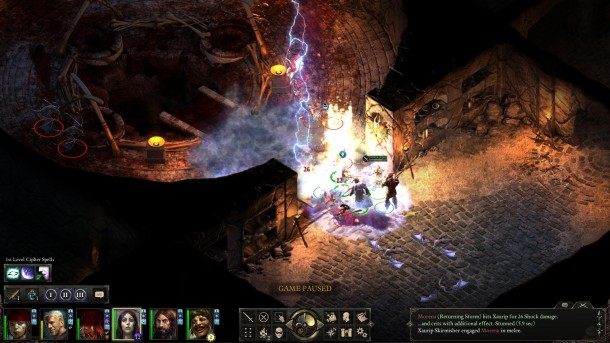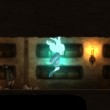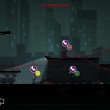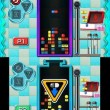Pillars of Eternity Review
Clone or homage? That Pillars of Eternity hews close to the Baldur's Gate/Icewind Dale formula can't be disputed. Its status within the ranks of its predecessors, however, is less obvious, given how slavishly devoted it is to a time when isometric role-playing games dominated players' imaginations. For all its complexities, Pillars of Eternity walks a narrow path already trod by the genre's greats, including the insurmountable Planescape: Torment and Baldur's Gate II, which rightfully remain atop the computer RPG hierarchy.
As much as I can see how blatantly it pokes my nostalgia buttons, I still lost myself in Pillars, which sets itself apart--just enough to tip itself into the "homage" bucket rather than the "clone" one--with its original fantasy universe, as well as with combat details that reduce frustration and keep the tempo moving. It claws at Planescape and Baldur's Gate from beneath their perches, and while it never threatens to replace them, Pillars rises to greatness of its own accord. In those first few hours, however, it relies on nostalgia and familiarity to gain your interest. This isn't a Dungeons & Dragons game, but the influence is clear from the moment of character creation, during which you choose a race, a class, and a backstory for your leading man or lady. Old favorites like Elves and Dwarfs are joined by original races like the Godlike, whose elemental head adornments preclude the wearing of hats and helmets; Familiar professions like barbarian and wizard are supported by the cipher, who builds up magical focus by landing attacks with a standard weapon.
The world you step into is equally comfortable, using narrative and artistic variations to remind you that this is not, in fact, a place you have visited before. You and your fellow party members--up to six of you journeying at any given time--may equip pistols or arequebuses in addition to swords, rapiers, crossbows, and the like. The soundtrack reliably recalls composer Michael Hoenig's Baldur's Gate music, but the uberdramatic Carmina Burana-esque chants, and the wild woodwind arpeggios you hear during battle, help to differentiate it. You lead your party from an isometric view, navigating forests and meadows populated by wolves, ogres, and bandits, but you also contend with dark spirits and eerie ancient machines that belong only to Pillars.
The gods, too, are different in this universe, taking such names as Woedica, Berath, and Magran, and they hold great sway over their followers, who live and die by faith. Pillars of Eternity tells a cautionary tale of the gods' influence over their worshipers, planting its thematic seeds when your own character becomes a watcher--that is, an individual who can see and interact with disembodied souls. Watchers may also peer into others' pasts, a skill that reveals some of the game's finest tales, which are trapped within specially marked citizens on your map. These tales are optional and self-contained, gleaned by reaching into bystanders' souls and reliving their memories, but they greatly benefit from developer Obsidian's flowery language. There is the tale of the berry-picker who foils a would-be assassin, who "grabs the figure's wrist and falls onto his back, planting a leg in the center of the figure's chest." A story of a small boy hoping to be a wizard's apprentice describes the wizards pyrotechnics thusly: "The mage finishes his show soon after, a giant silver dragon descending through the crowd and a thousand stars exploding into nothingness." Short, vibrant stories like these paint color into the basic shapes the main plot draws.
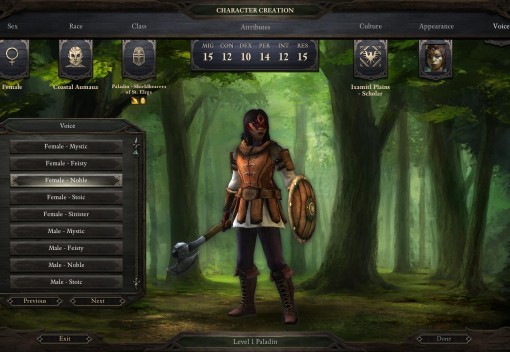
The games that spawned Pillars of Eternity were wordy, but Obsidian takes narrative density to new heights, dumping heaps of lore onto the table and overwhelming its personal stories with long histories of war replete with fictional words like "Fonestu" and "ferconyg." The writing is lovely: "How canst I, so lowly and worn, speak words of proper adulation?" cries the author of a prayer so aching in its beauty that you might be convinced it is a Biblical psalm. But it's easy to lose focus when you're drowning in embellishment, particularly when the occasional voiceover highlights the script's need for editing. In Pillars of Eternity, characters speak not like people speak, but how writers write: in lengthy sentences that require the merely adequate voice cast to pause for breath multiple times. Voiceover may also begin before you can take in the descriptive stage directions included in dialogue panels--and for that matter, may not accurately reflect the stage directions themselves. (The writing might refer to an emotional state that the voice acting does not convey, for instance.)
Ultimately, Pillars of Eternity does not benefit from its inconsistent acting, nor do its characters inspire the same kinds of emotional connections that Dragon Age: Origins does. Nevertheless, I was intrigued by many of their stories, and the Grieving Mother's most of all. This cipher's history was as mysterious to her as it was to me, and as I unveiled her past, I was more and more moved by her devotion to the well-being of infants and their mothers. The game's plot heavily involves the birth of children without souls, empty vessels known as hollowborn. Grieving Mother gives the primary quest a personal touch it desperately needs, just as a personable fighter called Eder provides down-home charm in the midst of rising social distrust.

The world you step into is comfortable, using narrative and artistic variations to remind you that this is not, in fact, a place you have visited before.
A number of complicated game systems weave their way in and out of this god-filled world. You align yourself with the game's various factions when navigating choice-filled quests, for instance, irritating bloodthirsty druids when you don't take kindly to their sacrificial ways, or supporting a type of soul magic called animancy in spite of the sanitarium's questionable research methods. Pillars of Eternity can't always keep up with its own systems: I ended the game with several quests showing active even when I'd reached failure states, and in two cases, when the quest line inexplicably failed to update when I'd completed assignments, as if the game could not account for the variables I introduced. Yet there's joy in watching the world pulse as a result of your gravity, as if you are directing the social tides. Pillars wraps with a narrated epilogue that nicely condenses the results of your journey. Your decisions, it turns out, have ramifications beyond the game (and, Pillars implies, on a potential sequel).
It is in battle that Pillars of Eternity most excels. When you lead your party into combat, the game pauses (in default settings, anyway), and you pause-and-unpause your way through various tactical decisions, attacking your foes and commanding magic in Baldur's Gate fashion. In time, the chants you hear when battle begins becomes an emotional call to arms, catalyzing your brain into action, and marshaling your fingers into gear. You click from one party member portrait to the next, assigning targets to your paladin, blessing your companions with your priest, and calling for your druid to shoot a bee swarm from her fingers. You've done this before, but Pillars' pleasant interface keeps your attention on the tactics and minimizes the clicks.


It's the endurance system that makes Pillars stand apart from its peers. While you must manage each combatant's health, that's a long-term affair; endurance is the more pressing concern once battle is underway. Taking damage reduces the character's endurance levels, and should he run out, he is out of commission until the battle is over. He is not dead, however, presuming he still has health remaining, though the game is over should your entire party run dry. Odd difficulty spikes could turn the old RPGs into laborious cycles of saving and reloading; Pillars of Eternity's endurance layer keeps you moving forward, sending you back to town only when someone needs sleep, or when you run out of camping supplies that allow you to rest along the way. That doesn't mean that Pillars can't be challenging, or that its tactically deficient. In fact, as the game progresses, you earn more ways of delivering raw damage instead of endurance damage, granting you more methods of weakening, disabling, and ultimately downing your most troublesome foes.
You find some of those foes in the ruins beneath Caed Nua, your personal stronghold, which you earn several hours into your adventure. When you're first granted access, the estate is is a ramshackle one, and your keep is notable mainly for its state of disarray. As time passes, however, you may construct more and more improvements, until the library's spiderwebs are dusted away and merchants stand at the ready to sell you their wares. Caed Nua is also a portal to various hands-off activities in which you assign an unused party member to a pending mission, and she returns with a bagful of copper and maybe a few gems or knicknacks. Once you build a barracks, you can even recruit hirelings who defend your keep from hostile wanderers, which is simple enough with the click of a button.
The deep dungeon beneath it notwithstanding, the stronghold doesn't add much in the way of meaningful gameplay; it's presence is primarily cosmetic and atmospheric, and its purpose is to reflect your increasing influence. It is a digital snowglobe, meant to be noticed and appreciated, rather than a vital system. As far as audiovisual details go, however, it's a fine one, and Pillars of Eternity occasionally impresses in that regard. One of my favorite touches is such a small one, but it reveals a certain level of care that I greatly appreciate. You earn various cosmetic pets over time, and at one point, I switched out the miniature wurm I preferred to a happy yellow lab. Eder called out to it as we ventured across Brackenbury, and my heart was warmed, knowing that attention was given to this small but elegant touch.


Appreciation can turn to distraction when the details don't align, however. This may mean the dialogue misgendering you in a specific conversation, or a missing description when you click on a particular environmental identification icon, even when your party is standing right next to it. Other idiosyncrasies are annoying but easily overlooked, such as the lack of a buyback tab at merchants, which means you have to scroll through all the junk you've unloaded with the seller when browsing his goods. Larger bugs still can crop up, too, however. The biggest one to detract from my playthrough, which caused double-clicking inventory items to remove passive effects, has since been fixed. Labeling problems that cause one-use scrolls to look unavailable even when your lore attribute is well beyond the requirement, however, have not.
It's easy to lose sight of those issues when you're lost in a fantasy and captured by a game's rhythms, however, and Pillars of Eternity effortlessly ensnares you, both by reminding you of the places you've been, and by showing you things you didn't expect. It is not changing the future, but it is repackaging the past in a way that deserves praise while falling into a few old traps--and creating a few of its own--along the way. You can easily dodge these traps, however, and emerge victorious in a world where the gods show you both scorn and favor, and it's up to you to hew your own path.

